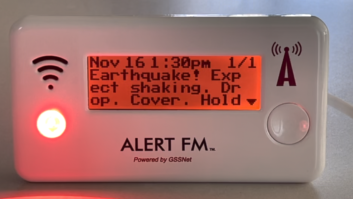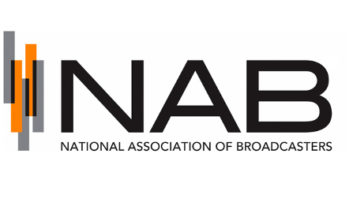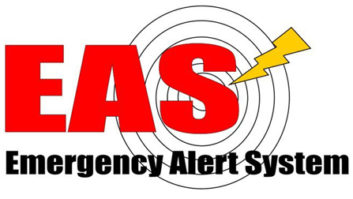The FCC recently asked EAS stakeholders to brainstorm what the future of emergency alerting in the United States might look like and how to plan a path forward.
The feedback collected covers a lot of ground but one thing is clear: There is new digital technology to consider, but the reliability of legacy EAS and the structure provided by radio and television broadcasters should not be underestimated, commenters say.
The FCC is reviewing the correspondence from its EAS Notice of Inquiry (NOI) released last fall hoping to find ways to enable greater functionality and accessibility. The NOI was part of a larger proceeding from the commission that focused on ways to enhance the visual aspect of EAS, which is expected to mostly impact television broadcasters.
The notice also reflected on the need to redesign legacy EAS, and perhaps have broadcasters rely solely on Common Alerting Protocol (CAP), to receive and relay emergency messages. The current EAS system consists of legacy broadcast infrastructure and internet-based CAP, which allows for better visual messaging. And the FCC has previously expressed interest in leveraging (CAP) to make significant improvements.
In the NOI the FCC asked: If legacy EAS can’t be reasonably modified to allow alert originators to distribute text and transcribe a two minute audio message, should legacy EAS architecture be redesigned all together?
Legacy EAS uses AFSK modulation to convert data to audible tones — is the 30 seconds of tone it would take to match text of 2:00 of audio too cumbersome?
The FCC asked, rather than focusing on ways to modify EAS to relay text or CAP, would it make sense to use legacy EAS only for the Emergency Action Notification (EAN) and NPT, but require the use of CAP for all other alerts?
Most of the comments received focused on the difficulties of upgrading legacy EAS — text has never been a part of legacy EAS and lacks the capabilities of CAP – but still conclude legacy EAS is the ultimate fallback when other communication infrastructure fails.
[Related: “NAB Voices Concerns About Proposed EAS Changes”]
Xperi told the FCC it believes the company’s HD Radio platform should be a central part of any plan to enhance EAS in this country.
“The FCC should look to digital emergency alerting as a model for modernizing the legacy EAS and, in addition, should actively incorporate the HD Radio emergency alerting protocol into its emergency alerting plans,” Xperi commented.
Xperi points out that broadcast radio is not subject to network congestion delays and outages imposed by natural disasters to LTE and 5G cell networks. The company estimates that HD Radio emergency alerting is utilized over 321 radio stations in the U.S. already. And there is a visual component to emergency messaging over HD Radio.
“HD Radio services today support text and image transmission. While the images are low-resolution (200px x 200px), this would be sufficient to send hazard-symbol images to all radios equipped with HD Radio Artist Experience,” it told the FCC. “For HD Radio products, the visual text message can be incorporated into standard program fields for as the text of an emergency alert message for pop-up display.”
HD Radio, which already formats CAP alerts, can also transmit non-real-time files to support additional messaging capability. “Audio clips or text transcripts may be efficiently transmitted in support of alert messaging services,” Xperi commented.
In addition, Xperi says HD Radio receivers currently deliver limited multimedia content, such as thumbnail images and, soon, those capabilities will expand to allow over-the-air transmission of graphics, images, pictures and maps, as well as URL links, which can provide enhanced critical information about threats.
Xperi, which conducted secondary tests for HD Radio in August 2021 when the commission and FEMA jointly coordinated a nationwide test of the IPAWS network, is also developing service validation protocols to address the potential for EAS message spoofing. The tech company says it is attuned to the concerns of automobile manufacturers about “potential cybersecurity vulnerabilities” that bad actors could exploit to compromise vehicle computers and other critical subsystems.
Other stakeholders replying to the FCC’s NOI included the National Weather Service (NWS), which asked the FCC to keep moving forward with development of emergency alerting. “If the Emergency Action Notification (EAN) is to remain in its current form, then evolution and improvements should be pursued for delivery of state and local alerts (non-EAN),” NWS wrote in its comments. “If EAS is intended to convey alert information beyond that of Presidential alerts, then EAS needs to be rethought and redesigned.”
[Related: “MMTC Proposes Compromise Approach to Multilingual Alerts”]
Digital Alert Systems (DAS), which manufactures EAS equipment, said many of the FCC’s forward thinking accessibility objectives to relay visual information to match audio components can mostly can be met with the requirement for broadcasters’ EAS equipment to immediately poll its configured CAP server for messages. However, it warns going forward with reliance on CAP-only dissemination would present significant risks.
“The EAS dissemination network provides an essential level of resiliency for times when internet dissemination of CAP messages is inhibited by regional, local, or last-mile interruptions. In short, our recommendation is that the public warning architecture can be ‘IP first,’ but must not be ‘IP only,’” DAS opined.
Another EAS stakeholder, equipment manufacturer Sage Alerting Systems, urges the FCC to adopt a centralized text-to-speech engine going forward.
“If the originator does not provide audio with their CAP message, each individual EAS participant must provide their own. Text to speech is provided in most EAS devices, but quality depends on tuning the lexicon, in particular for local location names and abbreviations. A centralized TTS engine, posting TTS audio to a server, supported by a government agency, will provide a significant improvement to CAP audio when audio is not provided by the originator,” Sage told the FCC.
Reply comments on the EAS Notice of Inquiry are due May 10. You can file comments to the FCC and read others here; enter 15-94 in the “Specify Proceeding” field.
Randy J. Stine has spent the past 40 years working in audio production and broadcast radio news. He joined Radio World in 1997 and covers new technology and regulatory issues. He has a B.A. in journalism from Michigan State University.






